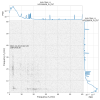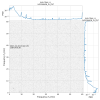[Louis, Sheila, Gabriele]
Today Sheila and Louis transitioned again to the new DARM offloading to check if the low-frequency non-stationarity in the strain was due to the ESD drive non-linearity. In summary: it works
First of all, GDS-CALIB_STRAIN was not yet calibrated for the new configuration, so in the "New DARM" offloading the absolute values of strain spectrum are wrong. Nevertheless we can study the non-stationarity.
The new DARM offloading scheme reduces the ESD drive and its RMS as expected in the few Hz region. There is an increase of ESD drive below 0.5 Hz, to be understood. But that increase doesn't seem to be a problem for now.
We can compare a period with the "Old DARM" scheme with a period with the 'New DARM" scheme by looking at a spectrogram and at a whitened spectrogram. The difference is evident: the fast non-stationarity evident with the old scheme is not visible in the new scheme.
We can also make a scatter plot of strain noise BLRMS between 16 and 60 Hz and the ESD RMS. Since the strain channel is not calibrate yet, absolute values of the strain BLRMS are not informative. Nevertheless, the correlation between ESD RMS and strain noise is gone.
As a final point, we can compare the bicoherence of ESD times ESD to DARM with the old scheme and the new scheme. All bicoherence is gone in the new configuration
All changes are reverted for now.







